Online retail sales growth slowed in May following a fairly strong April


Insight
Big data could help level the playing field for small- to medium-sized farmers. The Australian Farm Institute’s Mick Keogh and Precision Agriculture’s Andrew Whitlock discuss the opportunities and how to make the most of them.

Big data is helping farmers access valuable information and insights. The Australian Farm Institute’s Mick Keogh and Precision Agriculture’s Andrew Whitlock discuss boosting productivity, marketing more effectively – and the opportunity to start small.
‘Big data’ is the process of collecting large volumes of digital information from many different sources over a period of time, storing the information in a database and then analysing it to gain useful insights.
“One example of big data we use in our business is on-farm trials,” says Andrew Whitlock, Director and General Manager of Farm Services at Precision Agriculture. “By working with a network of farmers we’re able to build up data sets that show the responsiveness of various products across different regions and under various conditions. This is very useful information for famers to have.”
In the livestock sector, electronic identification systems are capturing information about weight and breeding.
“Combining genetic and slaughter data from a range of different beef cattle producers can help to identify the genetic traits that maximise production efficiency,” says Mick Keogh, Executive Director of the Australian Farm Institute (AFI). “Meat processors can link slaughter data to the electronic identification and send information back to the farmer, providing an accurate picture of how the animals perform.”
Big data can level the playing field for smaller farmers.
“Not so long ago, only large concerns could afford to collect and analyse information within their business,” says Keogh. “Now it costs much less to collect and access the data. There are also inexpensive tools and applications to compile and use the data in ways that assist production or, more significantly at this stage, help with marketing.
“For example, very small-scale livestock producers can post information about things that would be of interest to their target market on their website, such as a commitment to animal welfare or sustainability, and link this to a barcode on the product packaging. This introduces opportunities for developing niche markets that, in the past, would have been much too expensive to access. In many cases, the sentiment of ‘get big or get out’ no longer applies.”
Big data is also changing the way farmers treat their information.
“We tend to think we should jealously guard our own data but, quite often, the real benefits emerge when that data is more openly available,” says Keogh.
“Collaboration saves time in research. And, in a situation where, for example, major retailers have access to information about the availability of produce, there can be benefits on both sides.”
“Farm-specific digital agriculture is the first step to big data,” says Keogh. “Over the past decade, this has evolved from straightforward yield maps produced by harvesters to sophisticated, integrated systems such as auto drafting of stock and monitoring climate data, soil moisture and remote water troughs.
“Spray booms and agricultural implements are now routinely equipped with sensors so they can produce digital information. There’s information from the digital identification of livestock. And, of course, the ubiquitous mobile phone can also capture data that can be utilised for a whole range of different purposes.
“All of this is generating quite a considerable amount of data and farmers are in the throes of working out what has value, what needs to be stored and the most efficient way of managing data that is useful for them.”
It’s not surprising that some farmers feel overwhelmed by the sheer scale of the opportunities.
“We advise our clients to start small – perhaps as small as a single paddock – and focus on the easy wins first,” says Whitlock.
“If you want to, you can build up from there. And, if you don’t have time to crunch the data, or you’d rather be out doing farm work than sitting in front of a computer, it doesn’t cost much to employ someone to do it for you. You’ll then be able to make better decisions based on the information you receive.”
Most importantly, any venture into digital farming should be considered in the context of the business.
“We sometimes see people spending money on technology because it’s available and sounds clever, then struggling to find a way to use it,” says Whitlock. “We advise our clients to think first about the problem they would like to solve, or the process they would like to streamline, then look for the technology that can help.”
© National Australia Bank Limited. ABN 12 004 044 937 AFSL and Australian Credit Licence 230686.